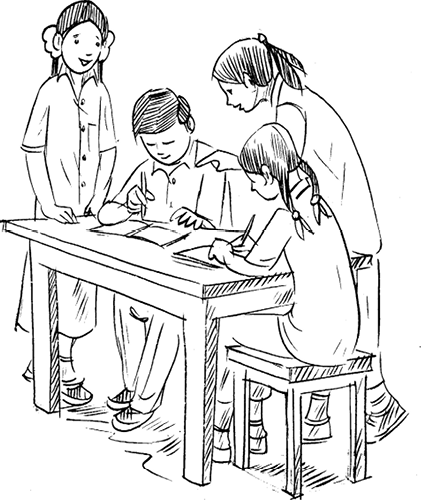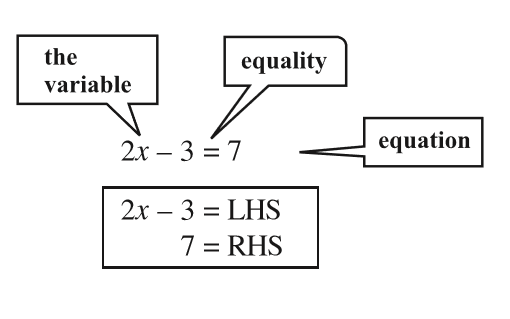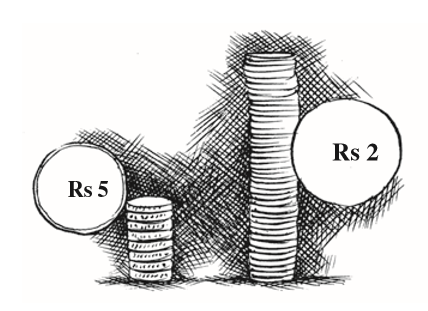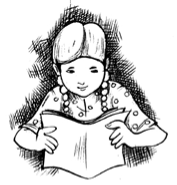Table of Contents
Chapter 2
Linear Equations in One Variable
2.1 Introduction
In the earlier classes, you have come across several algebraic expressions and equations.
Some examples of expressions we have so far worked with are:
5x, 2x – 3, 3x + y, 2xy + 5, xyz + x + y + z, x2 + 1, y + y2
Some examples of equations are: 5x = 25, 2x – 3 = 9, 
You would remember that equations use the equality (=) sign; it is missing in expressions.
Of these given expressions, many have more than one variable. For example, 2xy + 5 has two variables. We however, restrict to expressions with only one variable when we form equations. Moreover, the expressions we use to form equations are linear. This means that the highest power of the variable appearing in the expression is 1.
These are linear expressions:
2x, 2x + 1, 3y – 7, 12 – 5z, 
These are not linear expressions:
x2 + 1, y + y2, 1 + z + z2 + z3 (since highest power of variable > 1)
Here we will deal with equations with linear expressions in one variable only. Such equations are known as linear equations in one variable. The simple equations which you studied in the earlier classes were all of this type.
Let us briefly revise what we know:
(a) An algebraic equation is an equality involving variables. It has an equality sign. The expression on the left of the equality sign is the Left Hand Side (LHS). The expression on the right of the equality sign is the Right Hand Side (RHS).
(b) In an equation the values of the expressions on the LHS and RHS are equal. This happens to be true only for certain values of the variable. These values are the solutions of the equation.
x = 5 is the solution of the equation
2x – 3 = 7. For x = 5,
LHS = 2 × 5 – 3 = 7 = RHS
On the other hand x = 10 is not a solution of the equation. For x = 10, LHS = 2 × 10 –3 = 17. This is not equal to the RHS
(c) How to find the solution of an equation?
We assume that the two sides of the equation are balanced.
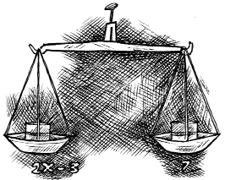
We perform the same mathematical operations on both sides of the equation, so that the balance is not disturbed. A few such steps give the solution.
2.2 Solving Equations which have Linear Expressions on one Side and Numbers on the other Side
Let us recall the technique of solving equations with some examples. Observe the solutions; they can be any rational number.
Example 1: Find the solution of 2x – 3 = 7
Solution:
Step 1 Add 3 to both sides.
2x – 3 + 3 = 7 + 3 (The balance is not disturbed)
or 2x = 10
Step 2 Next divide both sides by 2.
 =
= 
or x = 5 (required solution)
Example 2: Solve 2y + 9 = 4
Solution: Transposing 9 to RHS
2y = 4 – 9
or 2y = – 5
Dividing both sides by 2, y =  (solution)
(solution)
To check the answer: LHS = 2  + 9 = – 5 + 9 = 4 = RHS (as required)
+ 9 = – 5 + 9 = 4 = RHS (as required)
Do you notice that the solution  is a rational number? In Class VII, the equations we solved did not have such solutions.
is a rational number? In Class VII, the equations we solved did not have such solutions.
Example 3: Solve  =
= 
Solution: Transposing  to the RHS, we get
to the RHS, we get  =
= 
or  = – 4
= – 4
Multiply both sides by 3, x = – 4 × 3
or x = – 12 (solution)
Check: LHS =  RHS (as required)
RHS (as required)
Do you now see that the coefficient of a variable in an equation need not be an integer?
Example 4: Solve  – 7x = 9
– 7x = 9
Solution: We have  – 7x = 9
– 7x = 9
or – 7x = 9 –  (transposing
(transposing  to R H S)
to R H S)
or – 7x = 
or x =  (dividing both sides by – 7)
(dividing both sides by – 7)
or x = 
or x =  (solution)
(solution)
Check: LHS =  =
=  = RHS (as required)
= RHS (as required)
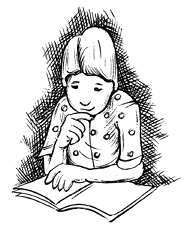
Exercise 2.1
Solve the following equations.
1. x – 2 = 7
2. y + 3 = 10
3. 6 = z + 2
4. 
5. 6x = 12
6. 
7. 
8. 1.6 = 
9. 7x – 9 = 16
10. 14y – 8 = 13
11. 17 + 6p = 9
12. 
2.3 Some Applications
We begin with a simple example.
Sum of two numbers is 74. One of the numbers is 10 more than the other. What are the numbers?
We have a puzzle here. We do not know either of the two numbers, and we have to find them. We are given two conditions.
(i) One of the numbers is 10 more than the other.
(ii) Their sum is 74.
We already know from Class VII how to proceed. If the smaller number is taken to be x, the larger number is 10 more than x, i.e., x + 10. The other condition says that the sum of these two numbers x and x + 10 is 74.
This means that x + (x + 10) = 74.
or 2x + 10 = 74
Transposing 10 to RHS, 2x = 74 – 10
or 2x = 64
Dividing both sides by 2, x = 32. This is one number.
The other number is x + 10 = 32 + 10 = 42
The desired numbers are 32 and 42. (Their sum is indeed 74 as given and also one number is 10 more than the other.)
We shall now consider several examples to show how useful this method is.
Example 5: What should be added to twice the rational number  to get
to get  ?
?
Solution: Twice the rational number  is
is  . Suppose x added to this number gives
. Suppose x added to this number gives  ; i.e.,
; i.e.,
 =
= 
or  =
= 
or x =  (transposing
(transposing  to RHS)
to RHS)
=  =
=  .
.
Thus  should be added to
should be added to  to give
to give  .
.
Example 6: The perimeter of a rectangle is 13 cm and its width is  cm. Find its length.
cm. Find its length.
Solution: Assume the length of the rectangle to be x cm.
The perimeter of the rectangle = 2 × (length + width)
= 2 × (x +  )
)
= 

The perimeter is given to be 13 cm. Therefore,
 = 13
= 13or  =
=  (dividing both sides by 2)
(dividing both sides by 2)
or x = 
= 
The length of the rectangle is  cm.
cm.
Example 7: The present age of Sahil’s mother is three times the present age of Sahil. After 5 years their ages will add to 66 years. Find their present ages.
Solution: Let Sahil’s present age be x years.
It is given that this sum is 66 years.
Therefore, 4x + 10 = 66
This equation determines Sahil’s present age which is x years. To solve the equation,
we transpose 10 to RHS,
4x = 66 – 10
or 4x = 56
or x =  = 14 (solution)
= 14 (solution)
Thus, Sahil’s present age is 14 years and his mother’s age is 42 years. (You may easily check that 5 years from now the sum of their ages will be 66 years.)
Example 8: Bansi has 3 times as many two-rupee coins as he has five-rupee coins. If he has in all a sum of ` 77, how many coins of each denomination does he have?
Solution: Let the number of five-rupee coins that Bansi has be x. Then the number of two-rupee coins he has is 3 times x or 3x.
The amount Bansi has:
(i) from 5 rupee coins, ` 5 × x = ` 5x
(ii) from 2 rupee coins, ` 2 × 3x = ` 6x
Hence the total money he has = ` 11x
But this is given to be ` 77; therefore,
11x = 77
or x =  = 7
= 7
Thus, number of five-rupee coins = x = 7
and number of two-rupee coins = 3x = 21 (solution)
(You can check that the total money with Bansi is ` 77.)
Example 9: The sum of three consecutive multiples of 11 is 363. Find these multiples.
Solution: If x is a multiple of 11, the next multiple is x + 11. The next to this is x + 11 + 11 or x + 22. So we can take three consecutive multiples of 11 as x, x + 11 and x + 22.

It is given that the sum of these consecutive multiples of 11 is 363. This will give the following equation:
or x + x + 11 + x + 22 = 363
or 3x + 33 = 363
or 3x = 363 – 33
or 3x = 330
or x = 
= 110
Hence, the three consecutive multiples are 110, 121, 132 (answer).
Alternatively, we may think of the multiple of 11 immediately before x. This is (x – 11). Therefore, we may take three consecutive multiples of 11 as x – 11, x, x + 11.
In this case we arrive at the equation
(x – 11) + x + (x + 11) = 363
or 3x = 363
We can see that we can adopt different ways to find a solution for the problem.
Example 10: The difference between two whole numbers is 66. The ratio of the two numbers is 2 : 5. What are the two numbers?
Solution: Since the ratio of the two numbers is 2 : 5, we may take one number to be 2x and the other to be 5x. (Note that 2x : 5x is same as 2 : 5.)
The difference between the two numbers is (5x – 2x). It is given that the difference is 66. Therefore,
5x – 2x = 66
or x =  = 121. Therefore,
= 121. Therefore,
x = 121, x – 11 = 110, x + 11 = 132
Hence, the three consecutive multiples are 110, 121, 132.
or 3x = 66
or x = 22
Since the numbers are 2x and 5x, they are 2 × 22 or 44 and 5 × 22 or 110, respectively.
The difference between the two numbers is 110 – 44 = 66 as desired.
Example 11: Deveshi has a total of ` 590 as currency notes in the denominations of ` 50, ` 20 and ` 10. The ratio of the number of ` 50 notes and ` 20 notes is 3:5. If she has a total of 25 notes, how many notes of each denomination she has?
Solution: Let the number of ` 50 notes and ` 20 notes be 3x and 5x, respectively.
But she has 25 notes in total.
Therefore, the number of ` 10 notes = 25 – (3x + 5x) = 25 – 8x
The amount she has
from ` 50 notes : 3x × 50 = ` 150x
from ` 20 notes : 5x × 20 = ` 100x
from ` 10 notes : (25 – 8x) × 10 = ` (250 – 80x)
Hence the total money she has = 150x + 100x + (250 – 80x) = ` (170x + 250)
But she has ` 590. Therefore, 170x + 250 = 590
or 170x = 590 – 250 = 340
or x =  = 2
= 2

The number of ` 50 notes she has = 3x
= 3 × 2 = 6
The number of ` 20 notes she has = 5x = 5 × 2 = 10
The number of ` 10 notes she has = 25 – 8x
= 25 – (8 × 2) = 25 – 16 = 9
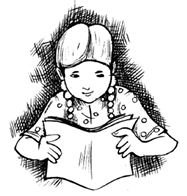
Exercise 2.2
 from a number and multiply the result by
from a number and multiply the result by  , you get
, you get  . What is the number?
. What is the number?2. The perimeter of a rectangular swimming pool is 154 m. Its length is 2 m more than twice its breadth. What are the length and the breadth of the pool?
3. The base of an isosceles triangle is  . The perimeter of the triangle is
. The perimeter of the triangle is  . What is the length of either of the remaining equal sides?
. What is the length of either of the remaining equal sides?
4. Sum of two numbers is 95. If one exceeds the other by 15, find the numbers.
5. Two numbers are in the ratio 5:3. If they differ by 18, what are the numbers?
6. Three consecutive integers add up to 51. What are these integers?
8. Three consecutive integers are such that when they are taken in increasing order and multiplied by 2, 3 and 4 respectively, they add up to 74. Find these numbers.
9. The ages of Rahul and Haroon are in the ratio 5:7. Four years later the sum of their ages will be 56 years. What are their present ages?
10. The number of boys and girls in a class are in the ratio 7:5. The number of boys is 8 more than the number of girls. What is the total class strength?
11. Baichung’s father is 26 years younger than Baichung’s grandfather and 29 years older than Baichung. The sum of the ages of all the three is 135 years. What is the age of each one of them?
12. Fifteen years from now Ravi’s age will be four times his present age. What is Ravi’s present age?
13. A rational number is such that when you multiply it by  and add
and add  to the product, you get
to the product, you get  . What is the number?
. What is the number?
14. Lakshmi is a cashier in a bank. She has currency notes of denominations ` 100, ` 50 and ` 10, respectively. The ratio of the number of these notes is 2:3:5. The total cash with Lakshmi is ` 4,00,000. How many notes of each denomination does she have?
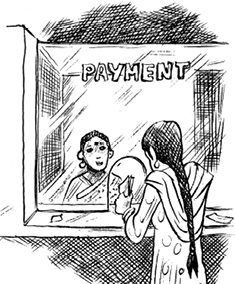
15. I have a total of ` 300 in coins of denomination ` 1, ` 2 and ` 5. The number of ` 2 coins is 3 times the number of ` 5 coins. The total number of coins is 160. How many coins of each denomination are with me?
16. The organisers of an essay competition decide that a winner in the competition gets a prize of ` 100 and a participant who does not win gets a prize of ` 25. The total prize money distributed is ` 3,000. Find the number of winners, if the total number of participants is 63.
2.4 Solving Equations having the Variable on both Sides
An equation is the equality of the values of two expressions. In the equation 2x – 3 = 7, the two expressions are 2x – 3 and 7. In most examples that we have come across so far, the RHS is just a number. But this need not always be so; both sides could have expressions with variables. For example, the equation 2x – 3 = x + 2 has expressions with a variable on both sides; the expression on the LHS is (2x – 3) and the expression on the RHS is (x + 2).
• We now discuss how to solve such equations which have expressions with the variable on both sides.
Example 12: Solve 2x – 3 = x + 2
Solution: We have
2x = x + 2 + 3
or 2x = x + 5
or 2x – x = x + 5 – x (subtracting x from both sides)
or x = 5 (solution)
Here we subtracted from both sides of the equation, not a number (constant), but a term involving the variable. We can do this as variables are also numbers. Also, note that subtracting x from both sides amounts to transposing x to LHS.
Example 13: Solve 5x + 
Solution: Multiply both sides of the equation by 2. We get
 =
= 
(2 × 5x) +  =
= 
or 10x + 7 = 3x – 28
or 10x – 3x + 7 = – 28 (transposing 3x to LHS)
or 7x + 7 = – 28
or 7x = – 28 – 7
or 7x = – 35
or x =  or x = – 5 (solution)
or x = – 5 (solution)
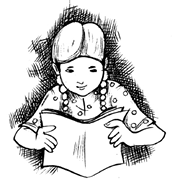
Exercise 2.3
Solve the following equations and check your results.
1. 3x = 2x + 18
2. 5t – 3 = 3t – 5
3. 5x + 9 = 5 + 3x
4. 4z + 3 = 6 + 2z
5. 2x – 1 = 14 – x
6. 8x + 4 = 3 (x – 1) + 7
7. x =  (x + 10)
(x + 10)
8.  + 1 =
+ 1 = 
9. 2y +  =
= 
10. 3m = 5 m – 
2.5 Some More Applications
Solution: Take, for example, a two-digit number, say, 56. It can be written as
56 = (10 × 5) + 6.
If the digits in 56 are interchanged, we get 65, which can be written as (10 × 6 ) + 5.
Let us take the two digit number such that the digit in the units place is b. The digit in the tens place differs from b by 3. Let us take it as b + 3. So the two-digit number is 10 (b + 3) + b = 10b + 30 + b = 11b + 30.
With interchange of digits, the resulting two-digit number will be 10b + (b + 3) = 11b + 3
If we add these two two-digit numbers, their sum is (11b + 30) + (11b + 3) = 11b + 11b + 30 + 3 = 22b + 33
It is given that the sum is 143. Therefore, 22b + 33 = 143
or 22b = 143 – 33
or 22b = 110
or b = 
or b = 5
Could we take the tens place digit to be (b – 3)? Try it and see what solution you get.
The units digit is 5 and therefore the tens digit is 5 + 3 which is 8. The number is 85.
Remember, this is the solution when we choose the tens digits to be 3 more than the unit’s digits. What happens if we take the tens digit to be (b – 3)?
Example 15: Arjun is twice as old as Shriya. Five years ago his age was three times Shriya’s age. Find their present ages.
Solution: Let us take Shriya’s present age to be x years.
Then Arjun’s present age would be 2x years.
Shriya’s age five years ago was (x – 5) years.
Arjun’s age five years ago was (2x – 5) years.
It is given that Arjun’s age five years ago was three times Shriya’s age.
Thus, 2x – 5 = 3(x – 5)
or 2x – 5 = 3x – 15
or 15 – 5 = 3x – 2x
or 10 = x
So, Shriya’s present age = x = 10 years.
Therefore, Arjun’s present age = 2x = 2 × 10 = 20 years.
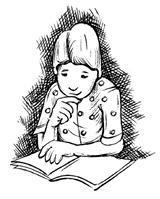
Exercise 2.4
1. Amina thinks of a number and subtracts  from it. She multiplies the result by 8. The result now obtained is 3 times the same number she thought of. What is the number?
from it. She multiplies the result by 8. The result now obtained is 3 times the same number she thought of. What is the number?
2. A positive number is 5 times another number. If 21 is added to both the numbers, then one of the new numbers becomes twice the other new number. What are the numbers?
3. Sum of the digits of a two-digit number is 9. When we interchange the digits, it is found that the resulting new number is greater than the original number by 27. What is the two-digit number?
4. One of the two digits of a two digit number is three times the other digit. If you interchange the digits of this two-digit number and add the resulting number to the original number, you get 88. What is the original number?
5. Shobo’s mother’s present age is six times Shobo’s present age. Shobo’s age five years from now will be one third of his mother’s present age. What are their present ages?
6. There is a narrow rectangular plot, reserved for a school, in Mahuli village. The length and breadth of the plot are in the ratio 11:4. At the rate `100 per metre it will cost the village panchayat ` 75000 to fence the plot. What are the dimensions of the plot?
7. Hasan buys two kinds of cloth materials for school uniforms, shirt material that costs him ` 50 per metre and trouser material that costs him ` 90 per metre.
For every 3 meters of the shirt material he buys 2 metres of the trouser material. He sells the materials at 12% and 10% profit respectively. His total sale is ` 36,600. How much trouser material did he buy?
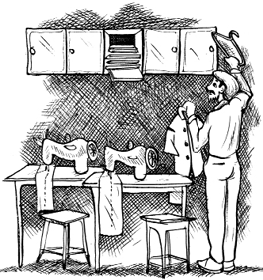
8. Half of a herd of deer are grazing in the field and three fourths of the remaining are playing nearby. The rest 9 are drinking water from the pond. Find the number of deer in the herd.
9. A grandfather is ten times older than his granddaughter. He is also 54 years older than her. Find their present ages.
10. Aman’s age is three times his son’s age. Ten years ago he was five times his son’s age. Find their present ages.
2.6 Reducing Equations to Simpler Form

Solution: Multiplying both sides of the equation by 6,
Why 6? Because it is the smallest multiple (or LCM) of the given denominators.
 =
= 
or 2 (6x + 1) + 6 = x – 3
or 12x + 2 + 6 = x – 3 (opening the brackets )
or 12x + 8 = x – 3
or 12x – x + 8 = – 3
or 11x + 8 = – 3
or 11x = –3 – 8
or 11x = –11
or x = – 1 (required solution)
Check: LHS =  =
= 
RHS = 
LHS = RHS. (as required)
Example 17: Solve 5x – 2 (2x – 7) = 2 (3x – 1) + 
Solution: Let us open the brackets,
LHS = 5x – 4x + 14 = x + 14
RHS = 6x – 2 +  =
= 
The equation is x + 14 = 6x + 
or 14 = 6x – x + 
or 14 = 5x + 
or 14 –  = 5x (transposing
= 5x (transposing  )
)
or  = 5x
= 5x
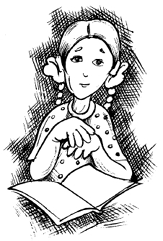
or  = 5x
= 5x
or x = 
Did you observe how we simplified the form of the given equation? Here, we had to multiply both sides of the equation by the LCM of the denominators of the terms in the expressions of the equation.
Therefore, required solution is x =  .
.
Check: LHS = 
=  =
= 

=  = LHS. (as required)
= LHS. (as required)
Note, in this example we brought the equation to a simpler form by opening brackets and combining like terms on both sides of the equation.
Exercise 2.5
Solve the following linear equations.
1.  2.
2.  3.
3. 
4.  5.
5.  6.
6. 
Simplify and solve the following linear equations.
9. 3(5z – 7) – 2(9z – 11) = 4(8z – 13) – 17
10. 0.25(4f – 3) = 0.05(10f – 9)
2.7 Equations Reducible to the Linear Form

Solution: Observe that the equation is not a linear equation, since the expression on its LHS is not linear. But we can put it into the form of a linear equation. We multiply both sides of the equation by (2x + 3),
 =
= 
Note that 2x + 3 ≠ 0 (Why?)
Notice that (2x + 3) gets cancelled on the LHS We have then,
x + 1 = 
We have now a linear equation which we know how to solve. Multiplying both sides by 8
8 (x + 1) = 3 (2x + 3)
This step can be directly obtained by ‘cross-multiplication’ 
or 8x + 8 = 6x + 9
or 8x = 6x + 9 – 8
or 8x = 6x + 1
or 8x – 6x = 1
or 2x = 1
or x = 
 .
.Check : Numerator of LHS =  + 1 =
+ 1 = 
Denominator of LHS = 2x + 3 =  + 3 = 1 + 3 = 4
+ 3 = 1 + 3 = 4
LHS = numerator ÷ denominator =  =
= 
Example 19: Present ages of Anu and Raj are in the ratio 4:5. Eight years from now the ratio of their ages will be 5:6. Find their present ages.
Solution: Let the present ages of Anu and Raj be 4x years and 5x years respectively.
After eight years. Anu’s age = (4x + 8) years;
After eight years, Raj’s age = (5x + 8) years.
Therefore, the ratio of their ages after eight years = 
This is given to be 5 : 6
Therefore,  =
= 
Cross-multiplication gives 6 (4x + 8) = 5 (5x + 8)
or 24x + 48 = 25x + 40
or 24x + 48 – 40 = 25x
or 24x + 8 = 25x
or 8 = 25x – 24x
or 8 = x
Therefore, Anu’s present age = 4x = 4 × 8 = 32 years
Raj’s present age = 5x = 5 × 8 = 40 years
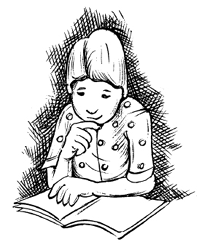
Exercise 2.6
Solve the following equations.
1.  2.
2.  3.
3. 
4.  5.
5. 
6. The ages of Hari and Harry are in the ratio 5:7. Four years from now the ratio of their ages will be 3:4. Find their present ages.
7. The denominator of a rational number is greater than its numerator by 8. If the numerator is increased by 17 and the denominator is decreased by 1, the number obtained is  . Find the rational number.
. Find the rational number.
What have we Discussed?
1. An algebraic equation is an equality involving variables. It says that the value of the expression on one side of the equality sign is equal to the value of the expression on the other side.
2. The equations we study in Classes VI, VII and VIII are linear equations in one variable. In such equations, the expressions which form the equation contain only one variable. Further, the equations are linear, i.e., the highest power of the variable appearing in the equation is 1.
3. A linear equation may have for its solution any rational number.
4. An equation may have linear expressions on both sides. Equations that we studied in Classes VI and VII had just a number on one side of the equation.
5. Just as numbers, variables can, also, be transposed from one side of the equation to the other.
6. Occasionally, the expressions forming equations have to be simplified before we can solve them by usual methods. Some equations may not even be linear to begin with, but they can be brought to a linear form by multiplying both sides of the equation by a suitable expression.
7. The utility of linear equations is in their diverse applications; different problems on numbers, ages, perimeters, combination of currency notes, and so on can be solved using linear equations.
